- + ACCUPLACER Mathematics
- + ACT Mathematics
- + AFOQT Mathematics
- + ALEKS Tests
- + ASVAB Mathematics
- + ATI TEAS Math Tests
- + Common Core Math
- + DAT Math Tests
- + FSA Tests
- + FTCE Math
- + GED Mathematics
- + Georgia Milestones Assessment
- + GRE Quantitative Reasoning
- + HiSET Math Exam
- + HSPT Math
- + ISEE Mathematics
- + PARCC Tests
- + Praxis Math
- + PSAT Math Tests
- + PSSA Tests
- + SAT Math Tests
- + SBAC Tests
- + SIFT Math
- + SSAT Math Tests
- + STAAR Tests
- + TABE Tests
- + TASC Math
- + TSI Mathematics
- + ACT Math Worksheets
- + Accuplacer Math Worksheets
- + AFOQT Math Worksheets
- + ALEKS Math Worksheets
- + ASVAB Math Worksheets
- + ATI TEAS 6 Math Worksheets
- + FTCE General Math Worksheets
- + GED Math Worksheets
- + 3rd Grade Mathematics Worksheets
- + 4th Grade Mathematics Worksheets
- + 5th Grade Mathematics Worksheets
- + 6th Grade Math Worksheets
- + 7th Grade Mathematics Worksheets
- + 8th Grade Mathematics Worksheets
- + 9th Grade Math Worksheets
- + HiSET Math Worksheets
- + HSPT Math Worksheets
- + ISEE Middle-Level Math Worksheets
- + PERT Math Worksheets
- + Praxis Math Worksheets
- + PSAT Math Worksheets
- + SAT Math Worksheets
- + SIFT Math Worksheets
- + SSAT Middle Level Math Worksheets
- + 7th Grade STAAR Math Worksheets
- + 8th Grade STAAR Math Worksheets
- + THEA Math Worksheets
- + TABE Math Worksheets
- + TASC Math Worksheets
- + TSI Math Worksheets
- + AFOQT Math Course
- + ALEKS Math Course
- + ASVAB Math Course
- + ATI TEAS 6 Math Course
- + CHSPE Math Course
- + FTCE General Knowledge Course
- + GED Math Course
- + HiSET Math Course
- + HSPT Math Course
- + ISEE Upper Level Math Course
- + SHSAT Math Course
- + SSAT Upper-Level Math Course
- + PERT Math Course
- + Praxis Core Math Course
- + SIFT Math Course
- + 8th Grade STAAR Math Course
- + TABE Math Course
- + TASC Math Course
- + TSI Math Course
- + Number Properties Puzzles
- + Algebra Puzzles
- + Geometry Puzzles
- + Intelligent Math Puzzles
- + Ratio, Proportion & Percentages Puzzles
- + Other Math Puzzles

How to Solve Percent Problems? (+FREE Worksheet!)
Learn how to calculate and solve percent problems using the percent formula.

Related Topics
- How to Find Percent of Increase and Decrease
- How to Find Discount, Tax, and Tip
- How to Do Percentage Calculations
- How to Solve Simple Interest Problems
Step by step guide to solve percent problems
- In each percent problem, we are looking for the base, or part or the percent.
- Use the following equations to find each missing section. Base \(= \color{black}{Part} \ ÷ \ \color{blue}{Percent}\) \(\color{ black }{Part} = \color{blue}{Percent} \ ×\) Base \(\color{blue}{Percent} = \color{ black }{Part} \ ÷\) Base
Percent Problems – Example 1:
\(2.5\) is what percent of \(20\)?
In this problem, we are looking for the percent. Use the following equation: \(\color{blue}{Percent} = \color{ black }{Part} \ ÷\) Base \(→\) Percent \(=2.5 \ ÷ \ 20=0.125=12.5\%\)
The Absolute Best Books to Ace Pre-Algebra to Algebra II
The Ultimate Algebra Bundle From Pre-Algebra to Algebra II
Percent problems – example 2:.
\(40\) is \(10\%\) of what number?
Use the following formula: Base \(= \color{ black }{Part} \ ÷ \ \color{blue}{Percent}\) \(→\) Base \(=40 \ ÷ \ 0.10=400\) \(40\) is \(10\%\) of \(400\).
Percent Problems – Example 3:
\(1.2\) is what percent of \(24\)?
In this problem, we are looking for the percent. Use the following equation: \(\color{blue}{Percent} = \color{ black }{Part} \ ÷\) Base \(→\) Percent \(=1.2÷24=0.05=5\%\)
The Best Book to Help You Ace Pre-Algebra
Pre-Algebra for Beginners The Ultimate Step by Step Guide to Preparing for the Pre-Algebra Test
Percent problems – example 4:.
\(20\) is \(5\%\) of what number?
Use the following formula: Base \(= \color{black}{Part} \ ÷ \ \color{blue}{Percent}\) \(→\) Base \(=20÷0.05=400\) \( 20\) is \(5\%\) of \(400\).
Exercises for Calculating Percent Problems
Solve each problem..
- \(51\) is \(340\%\) of what?
- \(93\%\) of what number is \(97\)?
- \(27\%\) of \(142\) is what number?
- What percent of \(125\) is \(29.3\)?
- \(60\) is what percent of \(126\)?
- \(67\) is \(67\%\) of what?
Download Percent Problems Worksheet
- \(\color{blue}{15}\)
- \(\color{blue}{104.3}\)
- \(\color{blue}{38.34}\)
- \(\color{blue}{23.44\%}\)
- \(\color{blue}{47.6\%}\)
- \(\color{blue}{100}\)
The Greatest Books for Students to Ace the Algebra
Pre-Algebra Exercise Book A Comprehensive Workbook + PreAlgebra Practice Tests
Pre-algebra in 10 days the most effective pre-algebra crash course, college algebra practice workbook the most comprehensive review of college algebra, high school algebra i a comprehensive review and step-by-step guide to mastering high school algebra 1, 10 full length clep college algebra practice tests the practice you need to ace the clep college algebra test.
by: Effortless Math Team about 4 years ago (category: Articles , Free Math Worksheets )
What people say about "How to Solve Percent Problems? (+FREE Worksheet!) - Effortless Math: We Help Students Learn to LOVE Mathematics"?
No one replied yet.
Leave a Reply Cancel reply
You must be logged in to post a comment.
Pre-Algebra Practice Workbook The Most Comprehensive Review of Pre-Algebra
Algebra i practice workbook the most comprehensive review of algebra 1, algebra ii practice workbook the most comprehensive review of algebra 2, algebra i for beginners the ultimate step by step guide to acing algebra i, algebra ii for beginners the ultimate step by step guide to acing algebra ii, pre-algebra tutor everything you need to help achieve an excellent score.
- ATI TEAS 6 Math
- ISEE Upper Level Math
- SSAT Upper-Level Math
- Praxis Core Math
- 8th Grade STAAR Math
Limited time only!
Save Over 45 %
It was $89.99 now it is $49.99
Login and use all of our services.
Effortless Math services are waiting for you. login faster!
Register Fast!
Password will be generated automatically and sent to your email.
After registration you can change your password if you want.
- Math Worksheets
- Math Courses
- Math Topics
- Math Puzzles
- Math eBooks
- GED Math Books
- HiSET Math Books
- ACT Math Books
- ISEE Math Books
- ACCUPLACER Books
- Premium Membership
- Youtube Videos
- Google Play
- Apple Store
Effortless Math provides unofficial test prep products for a variety of tests and exams. All trademarks are property of their respective trademark owners.
- Bulk Orders
- Refund Policy

- school Campus Bookshelves
- menu_book Bookshelves
- perm_media Learning Objects
- login Login
- how_to_reg Request Instructor Account
- hub Instructor Commons
- Download Page (PDF)
- Download Full Book (PDF)
- Periodic Table
- Physics Constants
- Scientific Calculator
- Reference & Cite
- Tools expand_more
- Readability
selected template will load here
This action is not available.

4.2: Percents Problems and Applications of Percent
- Last updated
- Save as PDF
- Page ID 142718

- Morgan Chase
- Clackamas Community College via OpenOregon
You may use a calculator throughout this module.
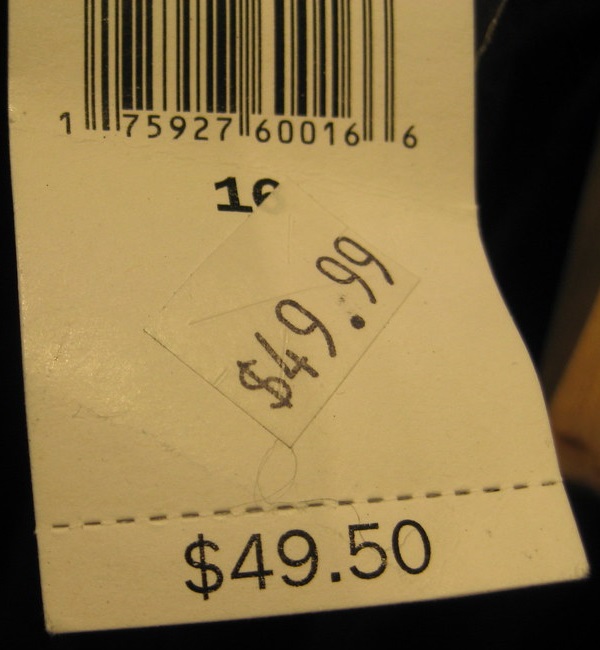
Recall: The amount is the answer we get after finding the percent of the original number. The base is the original number, the number we find the percent of. We can call the percent the rate.
When we looked at percents in a previous module, we focused on finding the amount. In this module, we will learn how to find the percentage rate and the base.
\(\text{Amount}=\text{Rate}\cdot\text{Base}\)
\(A=R\cdot{B}\)
We can translate from words into algebra.
- “is” means equals
- “of” means multiply
- “what” means a variable
Solving Percent Problems: Finding the Rate
Suppose you earned \(56\) points on a \(60\)-point quiz. To figure out your grade as a percent, you need to answer the question “\(56\) is what percent of \(60\)?” We can translate this sentence into the equation \(56=R\cdot60\).
Exercises \(\PageIndex{1}\)
1. \(56\) is what percent of \(60\)?
2. What percent of \(120\) is \(45\)?
1. \(93\%\) or \(93.3\%\)
2. \(37.5\%\)
Be aware that this method gives us the answer in decimal form and we must move the decimal point to convert the answer to a percent.
Also, if the instructions don’t explicitly tell you how to round your answer, use your best judgment: to the nearest whole percent or nearest tenth of a percent, to two or three significant figures, etc.
Solving Percent Problems: Finding the Base
Suppose you earn \(2\%\) cash rewards for the amount you charge on your credit card. If you want to earn $ \(50\) in cash rewards, how much do you need to charge on your card? To figure this out, you need to answer the question “\(50\) is \(2\%\) of what number?” We can translate this into the equation \(50=0.02\cdot{B}\).
3. $ \(50\) is \(2\%\) of what number?
4. \(5\%\) of what number is \(36\)?
3. $ \(2,500\)
5. An \(18\%\) tip will be added to a dinner that cost $ \(107.50\). What is the amount of the tip?
6. The University of Oregon women’s basketball team made \(13\) of the \(29\) three-points shots they attempted during a game against UNC. What percent of their three-point shots did the team make?
7. \(45\%\) of the people surveyed answered “yes” to a poll question. If \(180\) people answered “yes”, how many people were surveyed altogether?
5. $ \(19.35\)
6. \(44.8\%\) or \(45\%\)
7. \(400\) people were surveyed
Solving Percent Problems: Percent Increase
When a quantity changes, it is often useful to know by what percent it changed. If the price of a candy bar is increased by \(50\) cents, you might be annoyed because it’s it’s a relatively large percentage of the original price. If the price of a car is increased by \(50\) cents, though, you wouldn’t care because it’s such a small percentage of the original price.
To find the percent of increase:
- Subtract the two numbers to find the amount of increase.
- Using this result as the amount and the original number as the base, find the unknown percent.
Notice that we always use the original number for the base, the number that occurred earlier in time. In the case of a percent increase, this is the smaller of the two numbers.
8. The price of a candy bar increased from $ \(0.89\) to $ \(1.39\). By what percent did the price increase?
9. The population of Portland in 2010 was \(583,793\). The estimated population in 2019 was \(654,741\). Find the percent of increase in the population. [1]
8. \(56.2\%\) increase
9. \(12.2\%\) increase
Solving Percent Problems: Percent Decrease
Finding the percent decrease in a number is very similar.
To find the percent of decrease:
- Subtract the two numbers to find the amount of decrease.
Again, we always use the original number for the base, the number that occurred earlier in time. For a percent decrease, this is the larger of the two numbers.
10. During a sale, the price of a candy bar was reduced from $ \(1.39\) to $ \(0.89\). By what percent did the price decrease?
11. The number of students enrolled at Clackamas Community College decreased from \(7,439\) in Summer 2019 to \(4,781\) in Summer 2020. Find the percent of decrease in enrollment.
10. \(36.0\%\) decrease
11. \(35.7\%\) decrease
Relative Error
In an earlier module, we said that a measurement will always include some error, no matter how carefully we measure. It can be helpful to consider the size of the error relative to the size of what is being measured. As we saw in the examples above, a difference of \(50\) cents is important when we’re pricing candy bars but insignificant when we’re pricing cars. In the same way, an error of an eighth of an inch could be a deal-breaker when you’re trying to fit a screen into a window frame, but an eighth of an inch is insignificant when you’re measuring the length of your garage.
The expected outcome is what the number would be in a perfect world. If a window screen is supposed to be exactly \(25\) inches wide, we call this the expected outcome, and we treat it as though it has infinitely many significant digits. In theory, the expected outcome is \(25.000000...\)
To find the absolute error , we subtract the measurement and the expected outcome. Because we always treat the expected outcome as though it has unlimited significant figures, the absolute error should have the same precision (place value) as the measurement , not the expected outcome .
To find the relative error , we divide the absolute error by the expected outcome. We usually express the relative error as a percent. In fact, the procedure for finding the relative error is identical to the procedures for finding a percent increase or percent decrease!
To find the relative error:
- Subtract the two numbers to find the absolute error.
- Using the absolute error as the amount and the expected outcome as the base, find the unknown percent.
Exercisew \(\PageIndex{1}\)
12. A window screen is measured to be \(25\dfrac{3}{16}\) inches wide instead of the advertised \(25\) inches. Determine the relative error, rounded to the nearest tenth of a percent.
13. The contents of a box of cereal are supposed to weigh \(10.8\) ounces, but they are measured at \(10.67\) ounces. Determine the relative error, rounded to the nearest tenth of a percent.
12. \(0.1875\div25\approx0.8\%\)
13. \(0.13\div10.8\approx1.2\%\)

The tolerance is the maximum amount that a measurement is allowed to differ from the expected outcome. For example, the U.S. Mint needs its coins to have a consistent size and weight so that they will work in vending machines. A dime (10 cents) weighs \(2.268\) grams, with a tolerance of \(\pm0.091\) grams. [2] This tells us that the minimum acceptable weight is \(2.268-0.091=2.177\) grams, and the maximum acceptable weight is \(2.268+0.091=2.359\) grams. A dime with a weight outside of the range \(2.177\leq\text{weight}\leq2.359\) would be unacceptable.
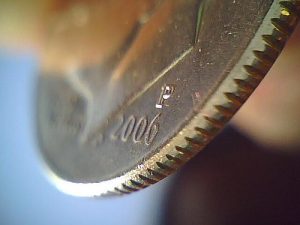
A U.S. nickel (5 cents) weighs \(5.000\) grams with a tolerance of \(\pm0.194\) grams.
14. Determine the lowest acceptable weight and highest acceptable weight of a nickel.
15. Determine the relative error of a nickel that weighs \(5.21\) grams.
A U.S. quarter (25 cents) weighs \(5.670\) grams with a tolerance of \(\pm0.227\) grams.
16. Determine the lowest acceptable weight and highest acceptable weight of a quarter.
17. Determine the relative error of a quarter that weighs \(5.43\) grams.
14. \(4.806\) g; \(5.194\) g
15. \(0.21\div5.000=4.2\%\)
16. \(5.443\) g; \(5.897\) g
17. \(0.24\div5.670\approx4.2\%\)
- www.census.gov/quickfacts/fact/table/portlandcityoregon,OR,US/PST045219 ↵
- https://www.usmint.gov/learn/coin-and-medal-programs/coin-specifications and https://www.thesprucecrafts.com/how-much-do-coins-weigh-4171330 ↵
If you're seeing this message, it means we're having trouble loading external resources on our website.
If you're behind a web filter, please make sure that the domains *.kastatic.org and *.kasandbox.org are unblocked.
To log in and use all the features of Khan Academy, please enable JavaScript in your browser.
7th grade foundations (Eureka Math/EngageNY)
Course: 7th grade foundations (eureka math/engageny) > unit 4.
- The meaning of percent
- Converting percents to decimals & fractions example
- Converting between percents, fractions, & decimals
- Finding a percent
- Percent of a whole number
Identifying percent amount and base
- Finding percents
Want to join the conversation?
- Upvote Button navigates to signup page
- Downvote Button navigates to signup page
- Flag Button navigates to signup page
Video transcript

Solving Percent Problems
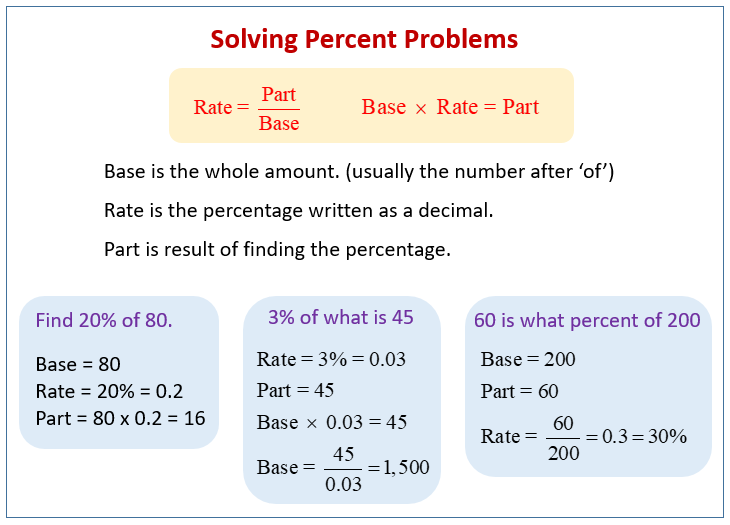

We welcome your feedback, comments and questions about this site or page. Please submit your feedback or enquiries via our Feedback page.

Solving Percent Problems
Identifying Amounts, Percents, and Bases
- Math Tutorials
- Pre Algebra & Algebra
- Exponential Decay
- Worksheets By Grade
In early mathematics, students come to understand percents as an amount of the base sum of an item, but the term "per cent" simply means "per hundred," so it can be interpreted as a portion out of 100, including fractions and sometimes numbers higher than 100.
In percent problems in mathematics assignments and examples, students are often asked to identify the three core parts of the problem—the amount, the percent, and the base—wherein the amount is the number taken out of the base by being reduced by a certain percentage.
The percent symbol is read "twenty-five percent" and simply means 25 out of 100. It is useful to be able to understand that a percent can be converted to a fraction and a decimal, meaning that 25 percent can also mean 25 over 100 which can be reduced to 1 over 4 and 0.25 when written as a decimal.
Practical Uses of Percentage Problems
Percentages may be the most useful tool of early mathematics education for adult life, especially when you consider that every mall has "15 percent off" and "half off" sales to entice shoppers to purchase their wares. As a result, it's critical for young students to grasp the concepts of calculating the amount reduced if they take a percentage away from of a base.
Imagine you're planning a trip to Hawaii with you and a loved one, and have a coupon that's only valid for the off-season of travel but guarantees 50 percent off the ticket price. On the other hand, you and your loved one can travel during the busy season and really experience the island life, but you can only find 30 percent discounts on those tickets.
If the off-season tickets cost $1295 and the on-season tickets cost $695 before applying the coupons, which would be the better deal? Based on the on-season tickets being reduced by 30 percent (208), the final total cost would be 487 (rounded up) while the cost for the off-season, being reduced by 50 percent (647), would cost 648 (rounded up).
In this case, the marketing team probably expected people would jump at the half-off deal and not research deals for a time when people want to travel out to Hawaii the most. As a result, some people wind up paying more for a worse time to fly!
Other Everyday Percent Problems
Percents occur almost as frequently as simple addition and subtraction in everyday life, from calculating the appropriate tip to leave at a restaurant to calculating gains and losses in recent months.
People who work on commission often get around 10 to 15 percent of the value of the sale they made for a company, so a car's salesman who sells a one hundred thousand dollar car would get between ten and fifteen thousand dollars in commission from his sale.
Similarly, those who save a portion of their salary for paying insurance and government taxes, or wish to dedicate part of their earnings to a savings account, must determine which percentage of their gross income they want to divest to these different investments.
- Learn to Calculate Percent Change
- How to Calculate Commissions Using Percents
- How to Say and Write Fractions in Spanish
- How to Calculate Percent Error
- Expressing Numbers in English
- Exponential Decay and Percent Change
- Calculate Simplest Formula From Percent Composition
- How to Calculate Mass Percent Composition
- Simple Rules for Rounding Numbers Correctly
- What Are Pie Charts and Why Are They Useful?
- What is the Base-10 Number System?
- Rational Numbers in Chinese
- Exponents and Bases
- How to Solve Exponential Decay Functions
- A Guide to Buying Reasonably Priced Firewood
- Fraction Worksheets and Printables
Percent , Rate , Base
Understanding percent , rate , and base is essential in various mathematical and real-life contexts. In this study guide, we will cover the basics of percent , rate , and base , and provide examples to help you grasp these concepts.
Percent means "per hundred" and is denoted by the symbol "%". It is used to express a number as a fraction of 100. For example, 25% is equivalent to the fraction 25/100 or the decimal 0.25.
A rate is a special ratio in which the two terms are in different units . For example, miles per hour (mph) is a rate . It compares the distance traveled to the time taken. Rates are often expressed using the word "per" or the symbol "/", such as 60 miles per hour or 60 mph.
The base is the original value in a percent problem. It is the whole or the original amount before a percentage is calculated. For example, if you're calculating 20% of 80, then 80 is the base .
Key Formulas
The following formulas are essential when dealing with percent , rate , and base :
Percent = (Part / Whole) * 100
Rate = (Part / Base )
Base = (Part / Rate )
Let's work through a few examples to illustrate these concepts:
Example 1: Calculating Percent
If you scored 35 out of 50 on a test, what is your score as a percentage?
Percent = (35 / 50) * 100 = 70%
Example 2: Calculating Rate
If a car travels 300 miles in 5 hours , what is its speed in miles per hour ?
Rate = 300 miles / 5 hours = 60 mph
Example 3: Finding the Base
If 15 is 20% of a number, what is the original number?
Base = 15 / 0.20 = 75
When studying percent , rate , and base , it's helpful to practice converting between fractions , decimals , and percentages . Additionally, working through real-life problems involving discounts, taxes, and tips can improve your understanding of these concepts.
Remember to use the key formulas and units to guide your problem-solving process. Understanding the relationship between percent , rate , and base will also make it easier to solve problems in various scenarios.
By mastering percent , rate , and base , you'll develop a valuable skill set for handling a wide range of mathematical and practical situations.
Good luck with your studies!
Read More...
◂ Math Worksheets and Study Guides Sixth Grade. Percent, Rate, Base
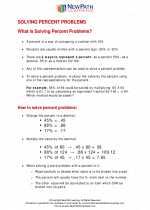
The resources above cover the following skills:
- Download and Print thousands of standards-based ELA, Social Study, Science and Math Worksheets and Study Guides!
- Terms of Use
- Privacy Policy
- Membership Benefits
- Completing Worksheets Online
- Share to Google Classroom
- NewPathLearning
A free service from Mattecentrum
Solving problems with percentages
- Price difference I
- Price difference II
- How many students?
To solve problems with percent we use the percent proportion shown in "Proportions and percent".
$$\frac{a}{b}=\frac{x}{100}$$
$$\frac{a}{{\color{red} {b}}}\cdot {\color{red} {b}}=\frac{x}{100}\cdot b$$
$$a=\frac{x}{100}\cdot b$$
x/100 is called the rate.
$$a=r\cdot b\Rightarrow Percent=Rate\cdot Base$$
Where the base is the original value and the percentage is the new value.
47% of the students in a class of 34 students has glasses or contacts. How many students in the class have either glasses or contacts?
$$a=r\cdot b$$
$$47\%=0.47a$$
$$=0.47\cdot 34$$
$$a=15.98\approx 16$$
16 of the students wear either glasses or contacts.
We often get reports about how much something has increased or decreased as a percent of change. The percent of change tells us how much something has changed in comparison to the original number. There are two different methods that we can use to find the percent of change.
The Mathplanet school has increased its student body from 150 students to 240 from last year. How big is the increase in percent?
We begin by subtracting the smaller number (the old value) from the greater number (the new value) to find the amount of change.
$$240-150=90$$
Then we find out how many percent this change corresponds to when compared to the original number of students
$$90=r\cdot 150$$
$$\frac{90}{150}=r$$
$$0.6=r= 60\%$$
We begin by finding the ratio between the old value (the original value) and the new value
$$percent\:of\:change=\frac{new\:value}{old\:value}=\frac{240}{150}=1.6$$
As you might remember 100% = 1. Since we have a percent of change that is bigger than 1 we know that we have an increase. To find out how big of an increase we've got we subtract 1 from 1.6.
$$1.6-1=0.6$$
$$0.6=60\%$$
As you can see both methods gave us the same answer which is that the student body has increased by 60%
Video lessons
A skirt cost $35 regulary in a shop. At a sale the price of the skirtreduces with 30%. How much will the skirt cost after the discount?
Solve "54 is 25% of what number?"
- Pre-Algebra
- The mean, the median and the mode
- Stem-and-Leaf Plots and Box-and-Whiskers Plot
- Calculating the outcome
- Combinations and permutations
- Finding the odds
- Probability of events
- Geometry – fundamental statements
- Circle graphs
- Angles and parallel lines
- Quadrilaterals, polygons and transformations
- Measure areas
- Pyramids, prisms, cylinders and cones
- Square roots and real numbers
- The Pythagorean Theorem
- Trigonometry
- Algebra 1 Overview
- Algebra 2 Overview
- Geometry Overview
- SAT Overview
- ACT Overview
Percent Maths Problems

Home / United States / Math Classes / 6th Grade Math / Solving Problems Based on Percentage
Solving Problems Based on Percentage
Percent is an alternate method of representing fractions and decimals. Here we will learn different methods of calculati ng the percent and the steps involved in each method. We will also look at some examples that will help you gain a better understanding of the concept. ...Read More Read Less
Table Of Contents

What is meant by percentage?
Solving problems based on percentages, finding the percentage of a number, finding the whole number from the percent, finding the whole using the ratio method, solved examples.
- Frequently Asked Questions
In mathematics, a percentage is a number or ratio that represents a fraction of 100. The symbol “ % ” is frequently used to represent it, and it has a few hundred years of history. While we are on the topic of percentages, one example will be, the decimal 0.35, or the fraction \(\frac{7}{20}\) , which is equivalent to 35 percent, or 35%.
By solving problems based on percentages, we can find the missing values and find the values of various unknowns in a given problem.
Find 40% of 200.
\(\frac{40}{100}\times 200\) Write the percentage as a fraction
\(\frac{2}{5}\times 200=800\) Simplify

First, write the percentage as a fraction or decimal. Then, divide the fraction or decimal by the part. This method applies to any situation in which a percentage and its value are given.
If 2 percent equals 80, multiply 80 by 100 and divide it by 2 to get 4000.
Prove that 20% of 120 is 24.
20% =\(\frac{20}{100}\) Write the percent as a fraction or decimal.
Using multiplication equation:
\(\frac{20}{100}\times 120=24\) Simplify
To prove the reverse of this solution we use the division equation:
\(\frac{24}{\frac{20}{100}}\) Simplify
\(\frac{2400}{20}=120\)
A ratio table is the table that shows the comparison between two units and shows the relationship between them.
Example 1: What is 25% of 50?
We have 25% of 50.
So, 25% of 50 = \(\frac{1}{4}\times 50\) Write the percentage as a fraction or decimal.
= \(\frac{50}{4}\) Simplify.
= 12.5
Example 2: Using the ratio table, answer the following question:
What is 60% of 200?
We have 60% of 200.
Now, we have to use the ratio table to find the part. Let one row represent the part and the other row represent the whole row in the table and find the equivalent ratio of 200.

The first column represents the percentage = \(\frac{60}{100}\)

So, 60% of 200 is 120.
Example 3: Find the whole of the number.
50% of what number is 45.
We have: 50% of what number is 45?
Use division equation
\(\frac{45}{50%}\) Write the percentage as a fraction or decimal
\(=\frac{45}{\frac{1}{2}}\) Simplify
So, \(45\times 2=90\)
Hence, 50% of 90 is 45
Example 4: Find the whole of the number using the ratio table.
140% of what number is 84
We have to find 140% of what number is 84.
Use the ratio table to find the part. Let one be the part and the other be the whole row in the table. Now, find the equivalent ratio of 200.

So, 140% of 60 is 84.
Example 5: A rectangular hall’s width is 60 percent of its length.
What are the room’s dimensions?

Solution:
Calculate the width of the room by taking 60% of 15 feet.
\(60%\times 15\) Write the percentage as a fraction or decimal.
= \(0.6\times 15\) Simplify
We can al so understand it with the help of a diagram:

The width is 9 feet.
Area of the rectangle = \(\text{length}\times \text{width}\)
= \(15\times 9\)
= 135
Hence, the area of the given room is 135 \(feet^2\).
Example 6: You have won a camping trip at an auction at your school fair that cost $80. Your bid is 40% of your maximum bid for the price of the camping trip. How much more would you be willing to pay for the trip if you hadn’t already paid the full price?

You are given the winning camping bid that represents the maximum bid as well as the percentage of your maximum bid. You must calculate how much more you would have paid for the camping trip if you had known how much more you were willing to pay.
Your winning bid is the part, and your maximum bid is the whole.
Create a model based on the fact that 40% of the total is $80 to determine the highest bid. Then divide the winning bid by the maximum bid to find out how much more you were willing to pay.

The maximum bid is $200 and the winning bid is $80. So, you would be willing to bid $200 – $80 = $120 more for the tickets.
How do you calculate a percentage?
To calculate a percentage, divide the given value by the total value and multiply the result by 100. That is “(value/total value) x 100%”. This is the formula for calculating percentages.
In mathematics, a percentage is a number or ratio that represents a fraction of 100 in mathematics. Percentage is usually represented by the symbol “%”. It is also written simply as “percent” or “pct”. For example, the decimal 0.35, or the fraction \(\frac{35}{100}\), is equivalent to 0.35.
What is the purpose of percentages?
Percentages are used to figure out “how much” or “how many” of something is to be taken from a given value. Percentage makes it easier to calculate the exact amount or figure being discussed. In order to determine whether a percentage increase or decrease has occurred, a comparison of fractions is done. This aids in calculating percentages of profit and loss, for example in real life situations.
Check out our other courses
Grades 1 - 12
Level 1 - 10
Solving Percent Problems

Percent is a great mathematical tool to express quantities and is used extensively in different things – from interest rates, discounts, and taxes to surveys, censuses, etc.
This article is your guide to percent and solving percent problems frequently appearing in major national examinations.
Click below to go to the main reviewers:
Ultimate UPCAT Reviewer
Ultimate NMAT Reviewer
Ultimate Civil Service Exam Reviewer
Ultimate PMA Entrance Exam Reviewer
Ultimate PNP Entrance Exam Reviewer
Ultimate LET Reviewer

Table of Contents
What does percent mean.
The word “percent” originated from the Latin phrase per centum, meaning “by hundred.” When we say “percent,” we refer to “parts per 100”. This means that a percent is a fraction with 100 as the denominator. The symbol % is used to indicate a percent.
For example, 3% means three parts per 100 or 3⁄100; 45% means 45⁄100; and 92% means 92⁄100.
Illustrating Percent
Suppose a vendor has 100 biscuits. If 10% of those biscuits are ube-flavored, 10⁄100 or 10 out of 100 biscuits are ube-flavored.
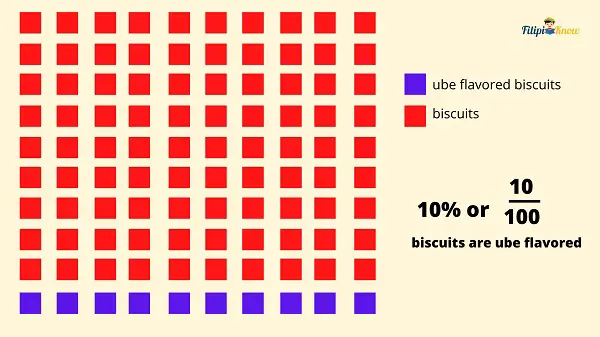
On the other hand, suppose there are 100 students in a school auditorium. If 42% of those students are honor students, 42⁄100 students, or 42 out of 100 students, are honor students.
Expressing Percent as Fraction and Decimal
Since percent means a fraction with 100 as the denominator, we can express a percent as a fraction or a decimal number .
Drop the percent sign and put 100 as the denominator to transform a percent into a fraction. For instance, 25% is simply 25⁄100.
Note that when 25⁄100 is reduced to its lowest terms, you will obtain ¼. This means that 25% is also equivalent to ¼.
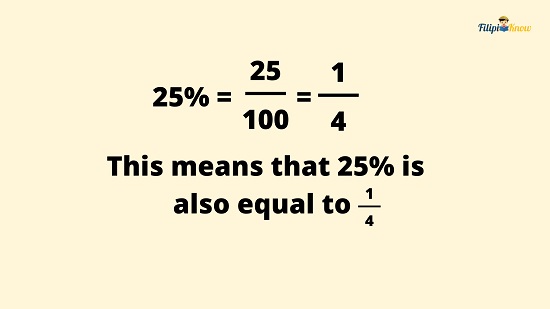
Furthermore, note that when you transform ¼ into its decimal form using the steps we have discussed in the previous reviewer , you will obtain 0.25. Hence, 25% is also equal to 0.25.
There is an easier way to transform percent into decimals . Drop the percent sign and move the decimal point two places to the left of the given number.

For example, 54% is equivalent to 0.54
Example: Transform 3% to decimal form.
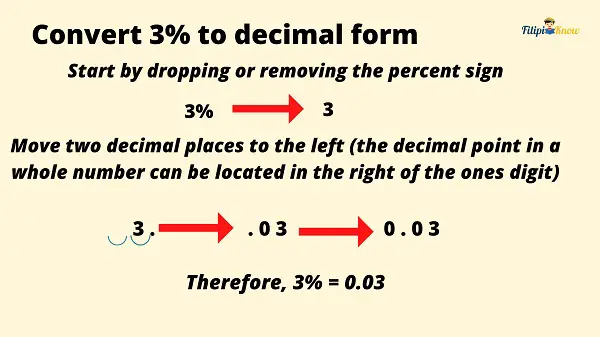
Suppose that your mom prepared ten pieces of your favorite cookies. You are excited to taste those cookies, but you realize that your brother ate 20% of the cookies that your mom prepared. What exactly is the number of cookies eaten by your brother?
To determine the answer to your question above, you must determine 20% of 10. This case involves the application of percentages.
The percentage is the result when you multiply a number by a percent. Returning to your problem about the number of cookies your brother ate, 20% of 10 can be determined if you multiply ten by 20%. The result after you multiply the numbers is called the percentage.
How To Find the Percentage
Follow these steps if you want to find the percentage:
Step 1: Convert the given percent (the one with the % sign) into decimals .
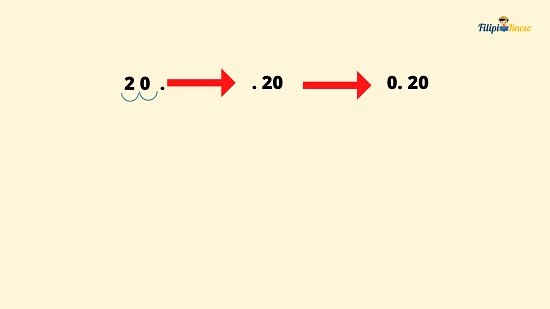
Again, to convert percent into its decimal form, we drop the percent sign and then move the decimal point two places to the left. Thus, 20% = 0.20
Step 2 : Multiply the decimal you have obtained from Step 1 to the given number. The result is the percentage.
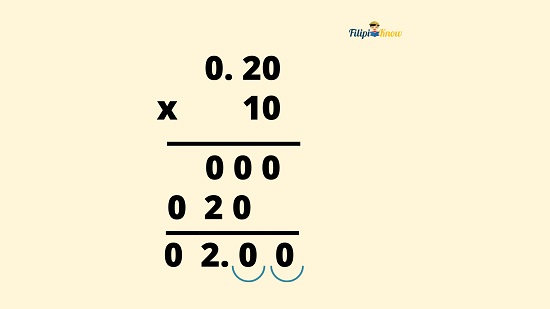
To multiply 0.20 by 10, we ignored the decimal point for a while and multiplied the given decimals like whole numbers. We have obtained 0200. Since 0.20 has two decimal places while 10 has none, the final answer should have two decimal places. We count two digits from the right of 0200 and put the decimal point there. Hence, the answer is 02.00, which is equivalent to 2.
Hence, 20% of 10 is 2. This means that out of 10 cookies your mother prepared, 2 of those were eaten by your brother.
Let us have another example.
Example: What is 50% of 120?
Step 1 : Convert the given percent (the one with the % sign) into decimals.
We drop the % sign of 50% and move the decimal point two places to the left.
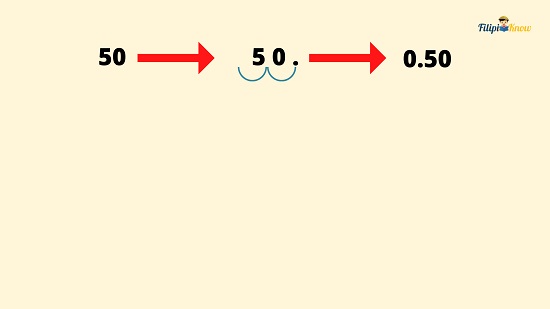
Thus, 50% = 0.50
Step 2: Multiply the decimal you have obtained from Step 1 to the given number. The result is the percentage.
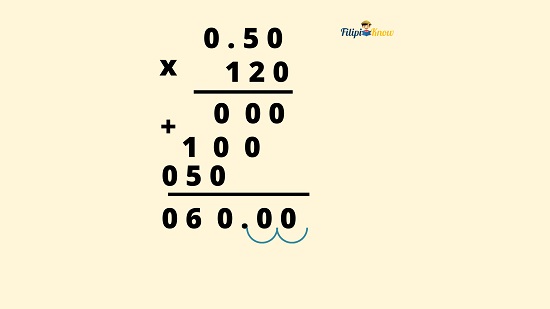
To multiply 0.50 by 120, we ignored the decimal point for a while and multiplied the given decimals like whole numbers. Through this process, we have obtained 06000. Since 0.50 has two decimal places while 120 has none, the final answer should have two decimal places. We count two digits from the right of 06000 and put the decimal point there. Hence, the answer is 060.00, which is equivalent to 60.
Hence, 50% of 120 is 60.
Simple Tricks in Computing Percentages
We always want to make our computations in mathematics faster and more accurate. For this reason, I will share two tricks you can use when computing percentages.
Trick #1: You can compute some percentages using only mental computation.
If you want to determine the 25%, 50%, 75%, or 100% of a number, you can do so without the help of pen and paper.
- 25% is equivalent to 25⁄100 or ¼. Hence, to find the 25% of a number, divide the given number by 4. Example: 25% of 40 is just 40 ÷ 4 = 10.
- 50% is equivalent to 50⁄100 or ½. Thus, to find the 50% of a number, divide the given number by 2. This means 50% of a number is just half the given number. Example: 50% of 40 is just 40 ÷ 2 = 20.
- 75% is equivalent to 75⁄100 or ¾. Thus, to find the 75% of a number, multiply the given number by three and then divide the result by 4. Example: 75% of 40 is just 40 x 3 = 120 ÷ 4 = 30.
- 100% is equivalent to 100⁄100 or 1. Thus, 100% of a number is the number itself . Example: 100% of 40 is just 40 itself.
Trick #2: X% of a number Y is equal to Y% of number X
This trick means we can transfer the % sign to the other number, and the result will be the same.
Example : What is 40% of 25?
Using trick #2, we can transfer the % sign from 40% to 25. Thus, we have 25%. This means 40% of 25 is the same as 25% of 40.
Thus, applying our first trick on finding the 25% of a number, 40 ÷ 4 = 10; hence, 40% of 25 is 10.
Example : What is 92% of 50?
92% of 50 is the same as 50% of 92. Hence, we can just divide 92 by 2 to obtain the answer, 92 ÷ 2 = 46
Therefore, 92% of 50 is 46.
Base and Rate
The base is the amount you are taking a percent of. Meanwhile, the rate is the percent you are calculating.
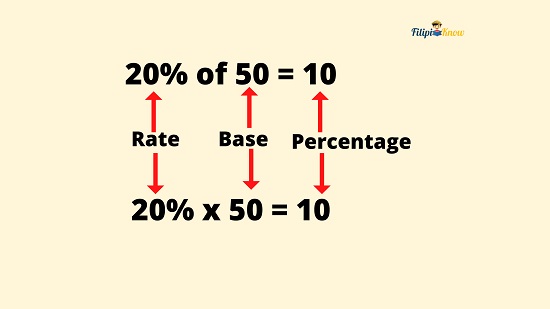
For example, if there are 50 students in a classroom and 20% of those students are honor students, it follows that ten students are honor students. 50 is the base since it is the amount we take a percent of. Meanwhile, 20% is the rate since we calculate the percentage. Lastly, 10 is the percentage.
The product of the base and the rate is the percentage .
Percentage = Base × Rate
Example: Determine the percentage, base, and rate if 20% of 90 is 18.
Since 90 x 20% = 90 x 0.20 = 18, 90 is the base, 20% is the rate, and 18 is the percentage.
Calculating Percentage, Base, and Rate
Formula to find the percentage.
The formula to find the percentage, as we have stated, is:
We can manipulate the mathematical equation above to obtain the formulas for computing the base and the rate:
Formula to Find the Base
Base = Percentage ÷ Rate
Formula to Find the Rate
Rate = Percentage ÷ Base
Example 1: If 10% of a number is 90, what is the number?
We can interpret this question as 10% of ______ = 90. Since “of” is a signal word for multiplication, it also implies 10% x ______ = 90
This means that 10% is the rate while 90 is the percentage. The unknown number is the base. Thus, we need to compute the base.
Using the formula to find the base:
Base = Percentage ÷ Rate
Base = 90 ÷ 10%
Convert the given percent into decimal:
Base = 90 ÷ 0.10
Now that you have already transformed the rate into decimal form, you may divide 90 by 0.10 to obtain the answer.
To perform division with decimal numbers , we need to transform the divisor (0.10) into a whole number by moving two decimal places to the right. Thus, the new divisor is 10. We also move two decimal places for the dividend (90). Thus, the new dividend is 9000.

We now perform long division with our new dividend and divisor:
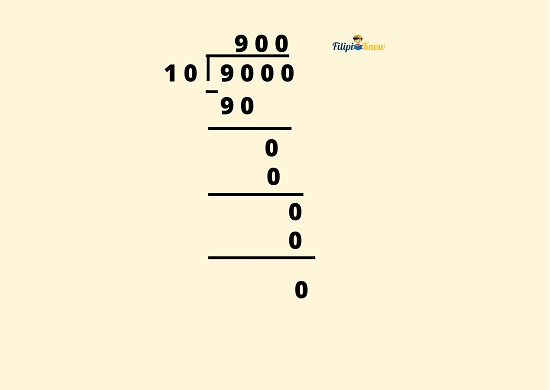
To find the base, we compute 90 ÷ 0.10 = 900
Hence, the base is 900.
Example 2: What percent of 720 is 90?
We can translate the question above in this form: _____% of 720 is 90 or _____% x 720 = 90. Therefore, 720 is the base, while 90 is the percentage. The missing number is the rate.
We will now use the formula for finding the rate.
Again, based on the given problem, the percentage is 90 while the base is 720
Rate = 90 ÷ 720
Notice that the dividend (the first number) is smaller than the divisor (the second number). In this case, you may apply the same steps in transforming fractions into decimal form because 90 ÷ 720 is a proper fraction (i.e., 90⁄720).
Let us divide 90 by 720 using the steps in transforming fractions into decimal form .
We add some zeros and decimal points to proceed with the division process.
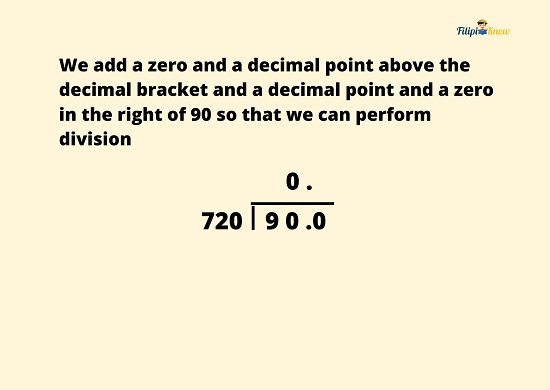
We can now divide 900 by 720.
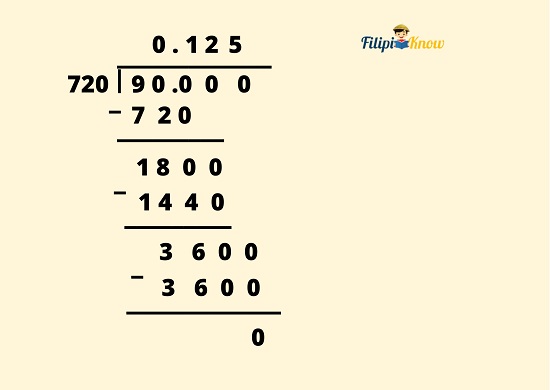
Note that every time the remainder becomes smaller than the divisor, we add zeros to 900 and the remainder to continue the division process.
The quotient we obtained is 0.125. Thus, 0.125 is our rate.
However, the rate must always be expressed with a percent sign. To do this, we multiply 0.125 by 100 or move two decimal places to the right of it and put a percent sign. Thus, 0.125 is equal to 12.5%.

Therefore, the rate is 12.5%
The Percentage, Base, and Rate Triangle
What if you forgot the formula to determine the percentage, base, or rate in a particular problem? Don’t worry because there is a fun way to derive these formulas.
Shown below is the Percentage, Base, and Rate Triangle . It is a triangle divided into three portions where P (for percentage) is written on the upper portion, and B (for base) and R (for rate) are written on the lower portions. There are also division signs in the triangle’s outer left and outer right parts and a multiplication sign below it.
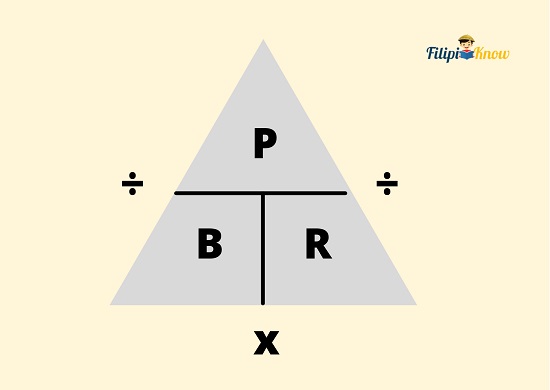
How To Use the Percentage, Base, and Rate Triangle
Suppose you are looking for the base. You have to cover the B in the triangle and look at the remaining letters and the operation between them. Notice that if you cover B, the remaining letters are P and R, with a division sign between them. This means that to find the base, you must divide P by R.

Next topic: Ratio and Proportion
Previous topic : Fundamental Operations on Fractions and Decimals
Return to the main article: The Ultimate Basic Math Reviewer
Download Printable Summary/Review Notes
Download printable flashcards, test yourself, 1. practice questions [free pdf download], 2. answer key [free pdf download], 3. math mock exam + answer key.
Written by Jewel Kyle Fabula
in Civil Service Exam , College Entrance Exam , LET , NAPOLCOM Exam , NMAT , PMA Entrance Exam , Reviewers , UPCAT
Last Updated May 3, 2023 05:59 PM
Jewel Kyle Fabula
Jewel Kyle Fabula is a Bachelor of Science in Economics student at the University of the Philippines Diliman. His passion for learning mathematics developed as he competed in some mathematics competitions during his Junior High School years. He loves cats, playing video games, and listening to music.
Browse all articles written by Jewel Kyle Fabula
Copyright Notice
All materials contained on this site are protected by the Republic of the Philippines copyright law and may not be reproduced, distributed, transmitted, displayed, published, or broadcast without the prior written permission of filipiknow.net or in the case of third party materials, the owner of that content. You may not alter or remove any trademark, copyright, or other notice from copies of the content. Be warned that we have already reported and helped terminate several websites and YouTube channels for blatantly stealing our content. If you wish to use filipiknow.net content for commercial purposes, such as for content syndication, etc., please contact us at legal(at)filipiknow(dot)net
Helping with Math
Applying Percentage, Base, and Rate 6th Grade Math Worksheets
Download applying percentage, base, and rate worksheets.
Click the button below to get instant access to these premium worksheets for use in the classroom or at a home.
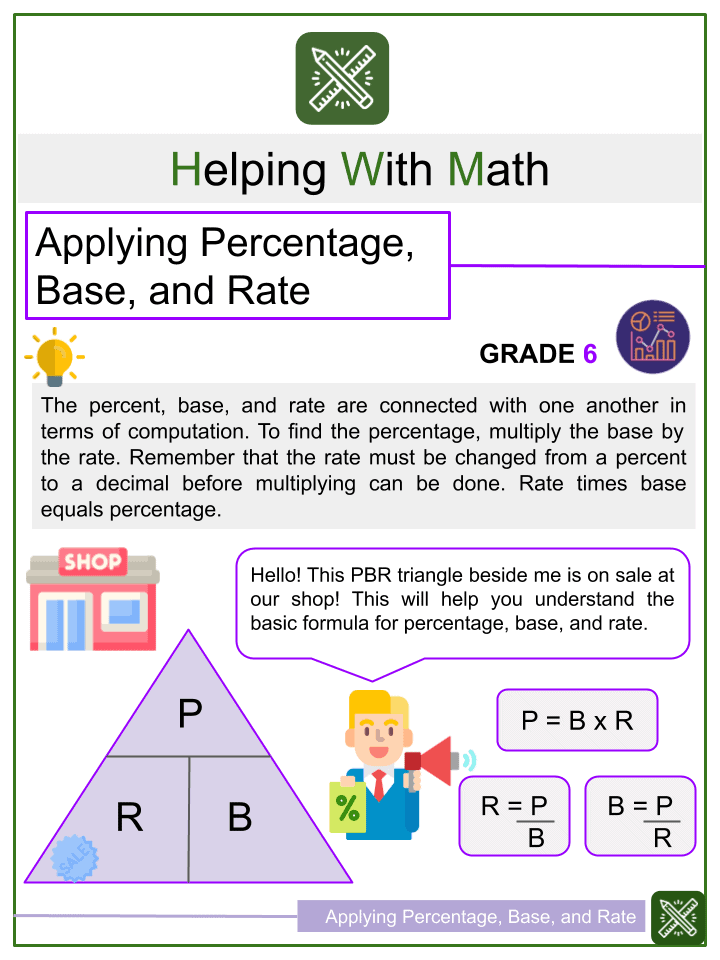
Download this Worksheet
This download is exclusively for Helping With Math Premium members!
To download this worksheet collection, click the button below to signup (it only takes a minute) and you'll be brought right back to this page to start the download!
Edit this Worksheet
Editing worksheet collections is available exclusively for Helping With Math Premium members.
To edit this worksheet collection, click the button below to signup (it only takes a minute) and you'll be brought right back to this page to start editing!
This worksheet can be edited by Premium members using the free Google Slides online software. Click the Edit button above to get started.
Download free sample
Not ready to purchase a subscription yet? Click here to download a FREE sample of this worksheet pack.
Definition:
The percent, base, and rate are connected with one another in terms of computation. To find the percentage , multiply the base by the rate. Remember that the rate must be changed from a percent to a decimal before multiplying can be done. Rate times base equals percentage.
PERCENTAGE (P=BxR) – The result obtained when a number is multiplied by a percent.
BASE (B=P/R) – The whole in a problem. The amount you are taking a percent of.
RATE (R=P/B) – The ratio of amount to the base. It is written as a percent.
Applying Percentage, Base, and Rate Worksheets
This is a fantastic bundle which includes everything you need to know about Applying Percentage, Base, and Rate across 15+ in-depth pages. These are ready-to-use Common core aligned Grade 6 Math worksheets. Each ready to use worksheet collection includes 10 activities and an answer guide. Not teaching common core standards ? Don’t worry! All our worksheets are completely editable so can be tailored for your curriculum and target audience.
Resource Examples
Click any of the example images below to view a larger version.
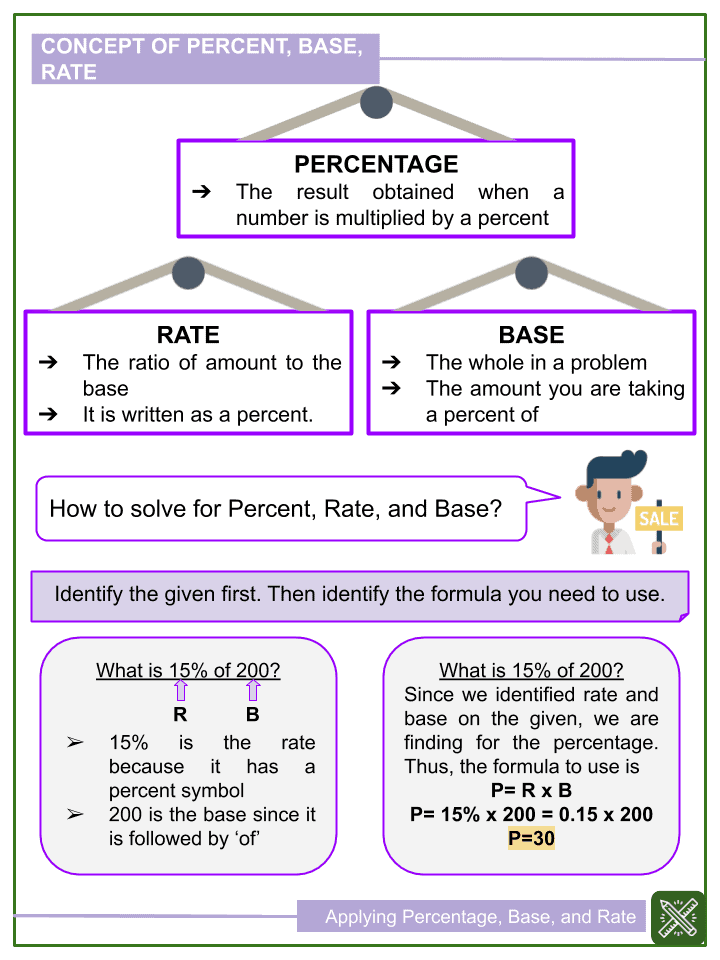
Even More Math Worksheets
- Understanding Exponents 6th Grade Math Worksheets
- Constructing Geometry Nets 6th Grade Math Worksheets
- Multiplying and Dividing Fractions 6th Grade Math Worksheets
- Examining Shapes of Distribution 6th Grade Math Worksheets
- Polygons in the Coordinate Plane 6th Grade Math Worksheets
- Distance Formula of Two Points 6th Grade Math Worksheets
- Solving Measures of Variability 6th Grade Math Worksheets
- Writing and Evaluating Algebraic Expressions 6th Grade Math Worksheets
- The Distributive Property and Algebraic Expressions 6th Grade Math Worksheets
Lifetime Membership Offer
Exclusive, limited time offer! One payment, lifetime access.
While we continue to grow our extensive math worksheet library, you can get all editable worksheets available now and in the future. We add 100+ K-8, common core aligned worksheets every month.
To find out more and sign up for a very low one-time payment , click now!
Similar Worksheets
The worksheets listed below are suitable for the same age and grades as Applying Percentage, Base, and Rate 6th Grade Math.
Understanding the properties of rotations, reflections, and translations of 2D figures 8th Grade Math Worksheets

Solving Linear Equations in One Variable Integral Coefficients and Rational Coefficients 8th Grade Math Worksheets

Interpreting linear functions in a form of y=mx+b and its graph 8th Grade Math Worksheets

Performing Operations using Scientific Notation 8th Grade Math Worksheets

Understanding Irrational Numbers 8th Grade Math Worksheets

Understanding Fundamental Counting Principle and Probability of Events 7th Grade Math Worksheets

Solving Area, Volume, and Surface Area of 2D and 3D Objects 7th Grade Math Worksheets

Solving Proportional Relationships Between Two Quantities 7th Grade Math Worksheets

Solving Word Problems Involving Linear Equations and Linear Inequalities 7th Grade Math Worksheets

Understanding Supplementary, Complementary, Vertical and Adjacent Angles 7th Grade Math Worksheets

Word Problems on Percentage
Word problems on percentage will help us to solve various types of problems related to percentage. Follow the procedure to solve similar type of percent problems.
Word problems on percentage:
1. In an exam Ashley secured 332 marks. If she secured 83 % makes, find the maximum marks.
Let the maximum marks be m.
Ashley’s marks = 83% of m
Ashley secured 332 marks
Therefore, 83% of m = 332
⇒ 83/100 × m = 332
⇒ m = (332 × 100)/83
⇒ m =33200/83
Therefore, Ashley got 332 marks out of 400 marks.
2. An alloy contains 26 % of copper. What quantity of alloy is required to get 260 g of copper?
Let the quantity of alloy required = m g
Then 26 % of m =260 g
⇒ 26/100 × m = 260 g
⇒ m = (260 × 100)/26 g
⇒ m = 26000/26 g
⇒ m = 1000 g
3. There are 50 students in a class. If 14% are absent on a particular day, find the number of students present in the class.
Solution:
Number of students absent on a particular day = 14 % of 50
i.e., 14/100 × 50 = 7
Therefore, the number of students present = 50 - 7 = 43 students.
4. In a basket of apples, 12% of them are rotten and 66 are in good condition. Find the total number of apples in the basket.
Solution:
Let the total number of apples in the basket be m
12 % of the apples are rotten, and apples in good condition are 66
Therefore, according to the question,
88% of m = 66
⟹ 88/100 × m = 66
⟹ m = (66 × 100)/88
⟹ m = 3 × 25
Therefore, total number of apples in the basket is 75.
5. In an examination, 300 students appeared. Out of these students; 28 % got first division, 54 % got second division and the remaining just passed. Assuming that no student failed; find the number of students who just passed.
The number of students with first division = 28 % of 300
= 28/100 × 300
= 8400/100
= 84
And, the number of students with second division = 54 % of 300
= 54/100 × 300
=16200/100
= 162
Therefore, the number of students who just passed = 300 – (84 + 162)
= 54
Questions and Answers on Word Problems on Percentage:
1. In a class 60% of the students are girls. If the total number of students is 30, what is the number of boys?
2. Emma scores 72 marks out of 80 in her English exam. Convert her marks into percent.
Answer: 90%
3. Mason was able to sell 35% of his vegetables before noon. If Mason had 200 kg of vegetables in the morning, how many grams of vegetables was he able to see by noon?
Answer: 70 kg
4. Alexander was able to cover 25% of 150 km journey in the morning. What percent of journey is still left to be covered?
Answer: 112.5 km
5. A cow gives 24 l milk each day. If the milkman sells 75% of the milk, how many liters of milk is left with him?
Answer: 6 l
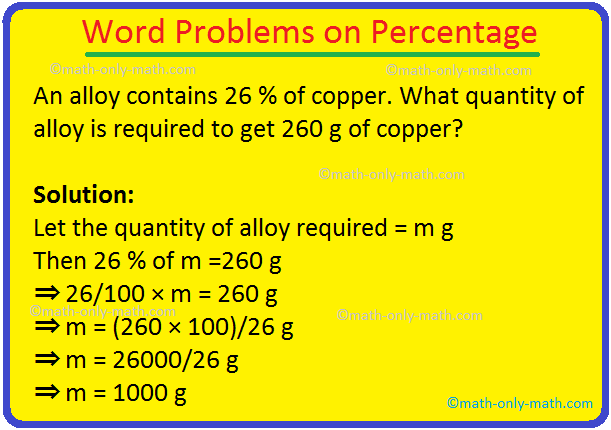
6. While shopping Grace spent 90% of the money she had. If she had $ 4500 on shopping, what was the amount of money she spent?
Answer: $ 4050
Fraction into Percentage
Percentage into Fraction
Percentage into Ratio
Ratio into Percentage
Percentage into Decimal
Decimal into Percentage
Percentage of the given Quantity
How much Percentage One Quantity is of Another?
Percentage of a Number
Increase Percentage
Decrease Percentage
Basic Problems on Percentage
Solved Examples on Percentage
Problems on Percentage
Real Life Problems on Percentage
Application of Percentage
8th Grade Math Practice From Word Problems on Percentage to HOME PAGE
New! Comments
Didn't find what you were looking for? Or want to know more information about Math Only Math . Use this Google Search to find what you need.
- Preschool Activities
- Kindergarten Math
- 1st Grade Math
- 2nd Grade Math
- 3rd Grade Math
- 4th Grade Math
- 5th Grade Math
- 6th Grade Math
- 7th Grade Math
- 8th Grade Math
- 9th Grade Math
- 10th Grade Math
- 11 & 12 Grade Math
- Concepts of Sets
- Probability
- Boolean Algebra
- Math Coloring Pages
- Multiplication Table
- Cool Maths Games
- Math Flash Cards
- Online Math Quiz
- Math Puzzles
- Binary System
- Math Dictionary
- Conversion Chart
- Homework Sheets
- Math Problem Ans
- Free Math Answers
- Printable Math Sheet
- Funny Math Answers
- Employment Test
- Math Patterns
- Link Partners
- Privacy Policy

Recent Articles
Methods of Prime Factorization | Division Method | Factor Tree Method
Apr 12, 24 01:43 PM
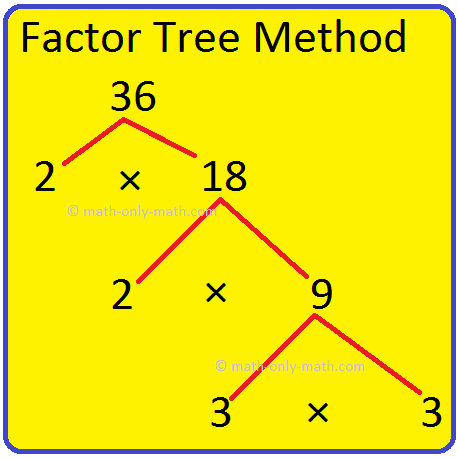
Divisibility Rules | Divisibility Test|Divisibility Rules From 2 to 18
Apr 12, 24 02:30 AM
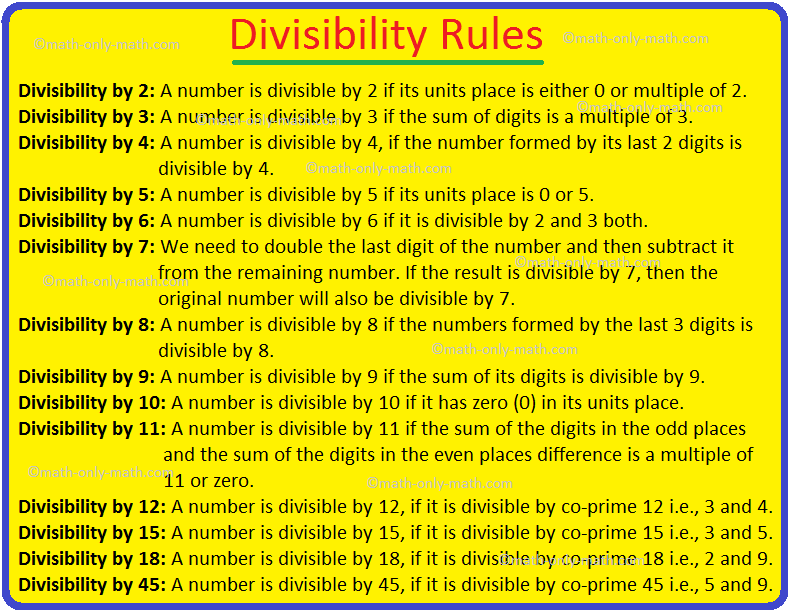
Prime and Composite Numbers | Prime Numbers | Composite Numbers
Apr 11, 24 10:53 PM
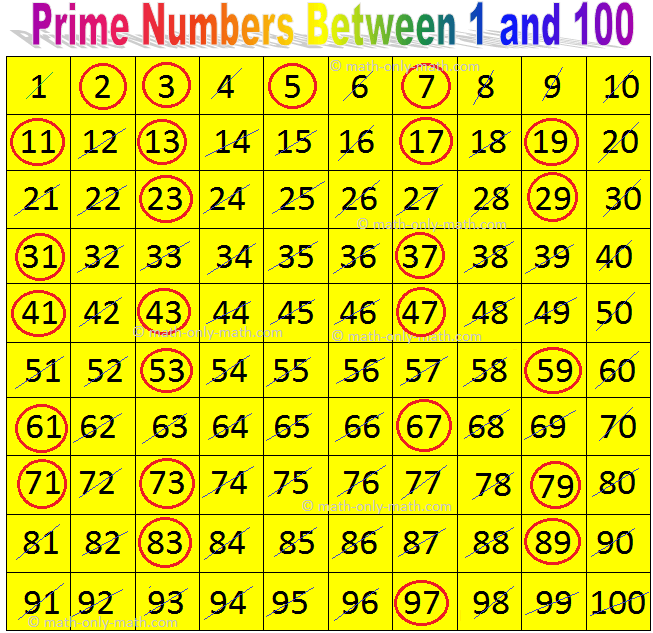
Even and Odd Numbers Between 1 and 100 | Even and Odd Numbers|Examples
Apr 11, 24 03:12 PM
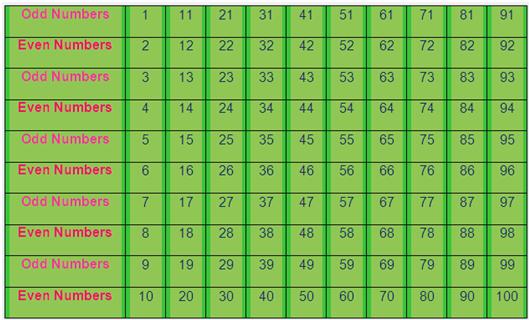
Worksheet on Factors and Multiples | Find the Missing Factors | Answer
Apr 11, 24 02:19 PM
Worksheet on Fraction into Percentage
Worksheet on Percentage into Fraction
Worksheet on Percentage into Ratio
Worksheet on Ratio into Percentage
Worksheet on Percentage into Decimal
Worksheet on Percentage of a Number
Worksheet on Finding Percent
Worksheet on Finding Value of a Percentage
Worksheet on Percentage of a Given Quantity
Worksheet on Word Problems on Percentage
Worksheet on Increase Percentage
Worksheet on Decrease Percentage
Worksheet on increase and Decrease Percentage
Worksheet on Expressing Percent
Worksheet on Percent Problems
Worksheet on Finding Percentage
© and ™ math-only-math.com. All Rights Reserved. 2010 - 2024.
We've detected unusual activity from your computer network
To continue, please click the box below to let us know you're not a robot.
Why did this happen?
Please make sure your browser supports JavaScript and cookies and that you are not blocking them from loading. For more information you can review our Terms of Service and Cookie Policy .
For inquiries related to this message please contact our support team and provide the reference ID below.
- Share full article
For more audio journalism and storytelling, download New York Times Audio , a new iOS app available for news subscribers.

- April 12, 2024 • 34:23 How One Family Lost $900,000 in a Timeshare Scam
- April 11, 2024 • 28:39 The Staggering Success of Trump’s Trial Delay Tactics
- April 10, 2024 • 22:49 Trump’s Abortion Dilemma
- April 9, 2024 • 30:48 How Tesla Planted the Seeds for Its Own Potential Downfall
- April 8, 2024 • 30:28 The Eclipse Chaser
- April 7, 2024 The Sunday Read: ‘What Deathbed Visions Teach Us About Living’
- April 5, 2024 • 29:11 An Engineering Experiment to Cool the Earth
- April 4, 2024 • 32:37 Israel’s Deadly Airstrike on the World Central Kitchen
- April 3, 2024 • 27:42 The Accidental Tax Cutter in Chief
- April 2, 2024 • 29:32 Kids Are Missing School at an Alarming Rate
- April 1, 2024 • 36:14 Ronna McDaniel, TV News and the Trump Problem
- March 29, 2024 • 48:42 Hamas Took Her, and Still Has Her Husband
How One Family Lost $900,000 in a Timeshare Scam
A mexican drug cartel is targeting seniors and their timeshares..
Hosted by Katrin Bennhold
Produced by Asthaa Chaturvedi and Will Reid
With Clare Toeniskoetter and Lynsea Garrison
Edited by Brendan Klinkenberg and Michael Benoist
Original music by Marion Lozano , Rowan Niemisto , Dan Powell , Pat McCusker and Will Reid
Engineered by Chris Wood
Listen and follow The Daily Apple Podcasts | Spotify | Amazon Music
Warning: this episode contains descriptions of violence.
A massive scam targeting older Americans who own timeshare properties has resulted in hundreds of millions of dollars sent to Mexico.
Maria Abi-Habib, an investigative correspondent for The Times, tells the story of a victim who lost everything, and of the criminal group making the scam calls — Jalisco New Generation, one of Mexico’s most violent cartels.
On today’s episode

Maria Abi-Habib , an investigative correspondent for The New York Times based in Mexico City.

Background reading
How a brutal Mexican drug cartel came to target seniors and their timeshares .
There are a lot of ways to listen to The Daily. Here’s how.
We aim to make transcripts available the next workday after an episode’s publication. You can find them at the top of the page.
The Daily is made by Rachel Quester, Lynsea Garrison, Clare Toeniskoetter, Paige Cowett, Michael Simon Johnson, Brad Fisher, Chris Wood, Jessica Cheung, Stella Tan, Alexandra Leigh Young, Lisa Chow, Eric Krupke, Marc Georges, Luke Vander Ploeg, M.J. Davis Lin, Dan Powell, Sydney Harper, Mike Benoist, Liz O. Baylen, Asthaa Chaturvedi, Rachelle Bonja, Diana Nguyen, Marion Lozano, Corey Schreppel, Rob Szypko, Elisheba Ittoop, Mooj Zadie, Patricia Willens, Rowan Niemisto, Jody Becker, Rikki Novetsky, John Ketchum, Nina Feldman, Will Reid, Carlos Prieto, Ben Calhoun, Susan Lee, Lexie Diao, Mary Wilson, Alex Stern, Dan Farrell, Sophia Lanman, Shannon Lin, Diane Wong, Devon Taylor, Alyssa Moxley, Summer Thomad, Olivia Natt, Daniel Ramirez and Brendan Klinkenberg.
Our theme music is by Jim Brunberg and Ben Landsverk of Wonderly. Special thanks to Sam Dolnick, Paula Szuchman, Lisa Tobin, Larissa Anderson, Julia Simon, Sofia Milan, Mahima Chablani, Elizabeth Davis-Moorer, Jeffrey Miranda, Renan Borelli, Maddy Masiello, Isabella Anderson and Nina Lassam.
Katrin Bennhold is the Berlin bureau chief. A former Nieman fellow at Harvard University, she previously reported from London and Paris, covering a range of topics from the rise of populism to gender. More about Katrin Bennhold
Advertisement

IMAGES
VIDEO
COMMENTS
Problems involving percents have any three quantities to work with: the percent, the amount, and the base. The percent has the percent symbol (%) or the word "percent." In the problem above, 15% is the percent off the purchase price. The base is the whole amount. In the problem above, the whole price of the guitar is $220, which is the base.
This math video tutorial explains how to solve percentage, base, and rate problems.Percentages Made Easy: https://www.youtube.com/watc...
Step by step guide to solve percent problems In each percent problem, we are looking for the base, or part or the percent. Use the following equations to find each missing section.
Solving Percent Problems: Percent Decrease. Finding the percent decrease in a number is very similar. To find the percent of decrease: Subtract the two numbers to find the amount of decrease. Using this result as the amount and the original number as the base, find the unknown percent.
Percentage Worksheet. Share this page to Google Classroom. Objective: I can find the base number in a percent problem. Example: 8 is 32% of what number? Solution: Answer: 25. Fill in all the gaps, then press "Check" to check your answers. Use the "Hint" button to get a free letter if an answer is giving you trouble.
This video will demonstrate how to solve problems about percentage, base and rate.Please like and follow our facebook page:https://www.facebook.com/MathTeach...
Identify the percent. Well, that looks like 25%, that's the percent. The amount and the base in this problem. And based on how they're wording it, I assume amount means when you take the 25% of the base, so they're saying that the amount-- as my best sense of it-- is that the amount is equal to the percent times the base. Let me do the base in ...
So we have the percent times the base. We have the percent times the base is equal to some amount. And you could try to solve this in your head. This is essentially saying 25% of some number, 25% times some number is equal to 150. If it helps, we could rewrite this as 0.25, which is the same thing as 25%. 0.25 times some number is equal to 150.
Examples, solutions, and videos that will help GMAT students review how to solve percent word problems. The following diagram shows some examples of solving percent problems using the part, base, rate formula. Scroll down the page for more examples and solutions of solving percent problems. Solving Percent Problems. Show Step-by-step Solutions.
Problems involving percents have any three quantities to work with: the percent, the amount, and the base. The percent has the percent symbol (%) or the word "percent." In the problem above, 15% is the percent off the purchase price. The base is the whole amount. In the problem above, the whole price of the guitar is $220, which is the base.
Percent problems can also be solved by writing a proportion. A proportion is an equation that sets two ratios or fractions equal to each other. With percent problems, one of the ratios is the percent, written as n 100. The other ratio is the amount to the base. Percent = amount base. Example.
In early mathematics, students come to understand percents as an amount of the base sum of an item, but the term "per cent" simply means "per hundred," so it can be interpreted as a portion out of 100, including fractions and sometimes numbers higher than 100. ... Russell, Deb. "Solving Percent Problems." ThoughtCo, Apr. 5, 2023, thoughtco.com ...
The base is the original value in a percent problem. It is the whole or the original amount before a percentage is calculated. For example, if you're calculating 20% of 80, then 80 is the base. Key Formulas. The following formulas are essential when dealing with percent, rate, and base: Percent = (Part / Whole) * 100. Rate = (Part / Base) Base ...
To solve problems with percent we use the percent proportion shown in "Proportions and percent". a b = x 100 a b = x 100. a b ⋅b = x 100 ⋅ b a b ⋅ b = x 100 ⋅ b. a = x 100 ⋅ b a = x 100 ⋅ b. x/100 is called the rate. a = r ⋅ b ⇒ Percent = Rate ⋅ Base a = r ⋅ b ⇒ P e r c e n t = R a t e ⋅ B a s e. Where the base is the ...
Problems that deal with percentage increase and decrease as well as problems of percent of quantities. ... y = 30 and solve for x which the original price. x - 0.22 x = 30 0.78 x = 30 x = $38.5 Check the solution to this problem by ... Solution to Problem 17 Total area of rectangle Ar = L * W Area of triangle At = (1/2) base * height = (1/2 ...
While we are on the topic of percentages, one example will be, the decimal 0.35, or the fraction \(\frac{7}{20}\), which is equivalent to 35 percent, or 35%. Solving Problems Based on Percentages By solving problems based on percentages, we can find the missing values and find the values of various unknowns in a given problem.
EXAMPLE 1: 15 is what percent of 120? To solve the problem, identify the given and unknown parts: Given: Base = 120 Unknown: Percent = x Amount = 15 Equation: 120 • x = 15 120• x 15 120 120 x 0.125 12.5% = == 0.125 120 15.000 Percent Proportion Problems involving the percent equation can also be solved with the proportion: Percent Amount (is)
We can translate the question above in this form: _____% of 720 is 90 or _____% x 720 = 90. Therefore, 720 is the base, while 90 is the percentage. The missing number is the rate. We will now use the formula for finding the rate. Rate = Percentage ÷ Base. Again, based on the given problem, the percentage is 90 while the base is 720
BASE (B=P/R) - The whole in a problem. The amount you are taking a percent of. RATE (R=P/B) - The ratio of amount to the base. It is written as a percent. Applying Percentage, Base, and Rate Worksheets. This is a fantastic bundle which includes everything you need to know about Applying Percentage, Base, and Rate across 15+ in-depth pages.
Convert the problem to an equation using the percentage formula: P% * X = Y. P is 10%, X is 150, so the equation is 10% * 150 = Y. Convert 10% to a decimal by removing the percent sign and dividing by 100: 10/100 = 0.10. Substitute 0.10 for 10% in the equation: 10% * 150 = Y becomes 0.10 * 150 = Y.
Word problems on percentage will help us to solve various types of problems related to percentage. Follow the procedure to solve similar type of percent problems. 1. In an exam Ashley secured 332 marks. If she secured 83 % makes, find the maximum marks.
This, we're told, will help solve the student debt crisis; allow cash-strapped 30- and 40-somethings to finally get into the housing market; and even help them make up for lost time on saving ...
A total solar eclipse created a celestial spectacle Monday in the skies over parts of Mexico, the United States and Canada after a nearly seven-year wait.
Traditional problem solving vs. problem solving with a culturally responsive approach; Strengths-based vs. deficit-based approach; How and why to reframe; Changing how we engage in the problem-solving process; What to Expect This module is presents school staff with an evidence-based, culturally responsive approach to problem solving with students.
Ronna McDaniel, TV News and the Trump Problem. March 29, ... Maria Abi-Habib, an investigative correspondent for The New York Times based in Mexico City. Image. Nicki and James, who asked that ...